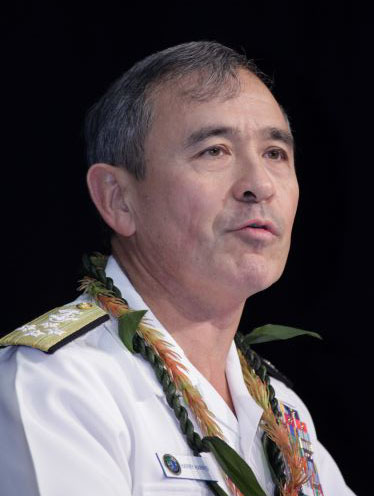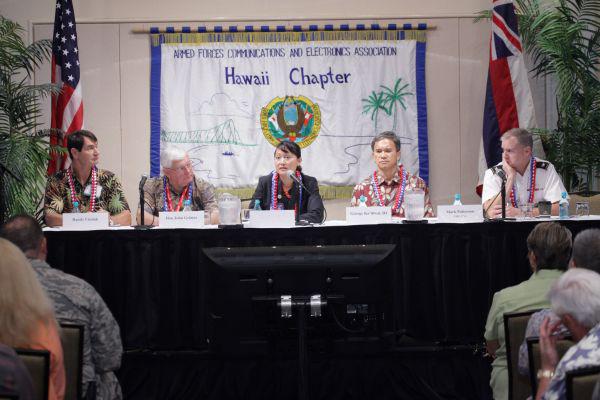The U.S. Navy Enters a New Era of Limits
TechNet Asia-Pacific 2013: Online Show Daily, Day 3
Quote of the Day:
“The number one question in the Pentagon today is, ‘What am I not going to spend money on?’”—Terry Halvorsen, Department of the Navy chief information officer
The U.S. Navy faces some hard decisions as it girds for a changing global security environment that features new and diverse threats and a greater demand for its presence in the Asia-Pacific region. The choices offered the Navy include developing a new way of obtaining needed technologies and capabilities; changing the way it establishes priorities in acquisition; applying social media to networking practices; and even turning back the clock to the era before modern network-centric warfare.
The third and final day of TechNet Hawaii 2013, held December 3-5 in Honolulu, Hawaii, featured extensive discussions of the challenges facing the Navy—and by connection, the U.S. Pacific Command (PACOM)—and potential solutions. Some of the solutions that seem logical could be difficult to implement; while others that would require innovative thinking and action may offer the best chance for truly effective change.
Terry Halvorsen, Department of the Navy chief information officer, set the tone for the day when he told the breakfast audience that defense spending must shift its outlook away from what it needs and toward where it can afford not spend money.
“The number one question in the Pentagon today is, ‘What am I not going to spend money on?’” Halvorsen stated.

Adm. Harry B. Harris Jr., USN, commander of the U.S. Pacific Fleet, describes a major challenge facing the fleet in its vast area of responsibility.
Calling it cyber economics, or risk math, Halvorsen said this approach will require establishing a balance around cost, mission and security. Halvorsen emphasized that information security must be weighed against cost and risk. “I don’t like the word security; I prefer risk—because it is a risk equation,” he declared.
“The money is not going to get better anytime soon,” he added. “It’s a pretty good bet that the money will get worse across the board.”
Halvorsen continued that this situation applies to all of the services. He noted that, while each of the military departments is in a different information technology environment, all of the staffs in the services are taking corresponding cuts.
While the Navy is cutting spending, it still will be spending a large amount of money on information technologies. “I don’t know too many companies that will spend $20-22 billion on cyber as the Navy does,” he stated.
Several solutions offered by speakers and panelists entailed a new type of relationship between the Navy and industry. Adm. Harry B. Harris Jr., USN, commander of the U.S. Pacific Fleet, stated, “We’re looking to our partners in industry to develop the new technologies and capabilities we need. And, we have do it in a fiscally constrained environment.”
The fleet needs robust cybersecurity for systems in all security domains. And, it must be able to conduct cross-domain chat between individuals in coalition operations, he said.
The admiral noted that the Navy cannot afford to invest in single mission systems and platforms. That now is a luxury that cannot be afforded, so industry must provide systems and platforms that can accommodate several missions.
Halvorsen expanded on that point, saying future defense information technology acquisitions are likely to focus on a set of services instead of specific elements. Current contracting tends to optimize for a specific element. For information technology, the specific is a service, and this approach leads to higher overall costs. Instead, acquisitions should optimize for the total set of services.
This is hard to do, he added. Accordingly, bidders likely will consist of industry teams bringing diverse expertise to the acquisition table. Halvorsen cited the Navy’s Next-Generation Enterprise Network (NGEN) acquisition as an example of the future. “NGEN is a teamed acquisition,” he pointed out. “That trend is going to continue. You just don’t have all the expertise in a single company.
”The industry teams that can bring together a coalition that can get at the total cost of performance and total cost of the system will do better than industries that don’t,” he predicted.
Halvorsen suggested that one overarching approach would be to adopt requirements reform. This entails defining what is needed, not what is wanted. But that effort must be part of a larger thrust toward innovation in business.
“If we just stop at acquisition reform, we won’t get any better,” Halvorsen said. “We have to look at money reform, how you execute money.
“Remember, I don’t borrow money,” he pointed out. “I need you [industry] to think about how we get to better financing for the things you propose. Maybe you share the risk and share the return. I need innovative thought on that.”
Yet even if sweeping acquisition reform is enacted, the Navy still faces serious operational challenges. In the event of a conflict in the vast Asia-Pacific region, the Pacific Fleet could find itself without its core information assets. Adm. Harris said the fleet now is planning for operation in a disconnected, intermittent, low-bandwidth environment, or DIL.
This will require learning new ways of carrying out missions without the assets that sailors have trained with over the past decade. “After years of boosting our bandwidth, now we know we will have to learn—or re-learn—how to operate in a low bandwidth environment,” the admiral stated.
“DIL is a challenge even in a good day in the maritime domain, with its vast distances—not to mention an adversary-induced DIL environment,” he pointed out.
Mark your calendar for TechNet Asia-Pacific 2014, December 9-11 at the Hilton Hawaiian Village in Honolulu, Hawaii.






Comments